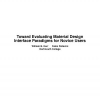Free Online Productivity Tools
i2Speak
i2Symbol
i2OCR
iTex2Img
iWeb2Print
iWeb2Shot
i2Type
iPdf2Split
iPdf2Merge
i2Bopomofo
i2Arabic
i2Style
i2Image
i2PDF
iLatex2Rtf
Sci2ools
SIGGRAPH
2010
ACM
2010
ACM
Toward evaluating material design interface paradigms for novice users
Material design is the process by which artists specify the reflectance
properties of a surface, such as its diffuse color and specular
roughness. We present a user study to evaluate the relative
benefits of different material design interfaces, focusing on novice
users since they stand to gain the most from intuitive interfaces.
Specifically, we investigate the editing of the parameters of analytic
bidirectional distribution functions (BRDFs) using three interface
paradigms: physical sliders by which users set the parameters of
analytic BRDF models, such as diffuse albedo and specular roughness;
perceptual sliders by which users set perceptually-inspired
parameters, such as diffuse luminance and gloss contrast; and image
navigation by which material variations are displayed in arrays
of image thumbnails and users make edits by selecting them.
We investigate two design tasks: precise adjustment and artistic exploration.
We collect objective and subjective data, finding th...
| Added | 28 Jul 2010 |
| Updated | 29 Jul 2010 |
| Type | Conference |
| Year | 2010 |
| Where | SIGGRAPH |
| Authors | William B. Kerr, Fabio Pellacini |
Comments (0)

